Red Curry with Kaffir Lime Leaves Brings Back Memories of Steamy Bangkok
My mother, Pranee, is 75 now, and one of the great benefits of having her live with us is that we’re growing close again and I’m getting to learn how to cook many of my favorite childhood foods. Charles loves spicy Thai food, so he’s always an enthusiastic diner.
With my hectic work life and Charles’ unpredictable schedule as a Realtor, Mom helps out by cooking meals for us four days during the week. Usually on Saturday or Sunday, I’ll sit with her and plan our dinner menu for the week so that she can do her grocery shopping. My Mac has Thai fonts, and one of the bonuses to this menu-planning exercise is I get to practice my Thai, writing out the menu, with my mother laughing at my first attempts, and then correcting my apparently awful spelling with her help.
My mother’s dishes have been featured in our blog a few times, but I’ve decided that over the next year or so, while she’s in good health and good spirits, I’m going to enlist her help in teaching me how to cook my favorite childhood dishes, and I’ll share those recipes, techniques and some of my childhood memories with you.
I figure if I don’t learn how to cook those dishes now, I will be sorry when she’s no longer alive. Plus, cooking those dishes long after she’s gone will bring back my memories of playing in the kitchen with her.
Two plants always bring to mind my homeland: One is lemongrass; the other is kaffir lime. In Thailand, my uncle had them growing in large dragon pots, and their unique double-lobed leaves would glisten in the sunlight. Whenever you would brush up against the plants, you could smell the lemony oil rub off their leaves onto your skin. In the summertime, some of my uncle’s kaffir lime plants would be laden with fruit, which looked very much like limes, but with a bumpy skin as if they had been attacked with bouts of warts.
When we lived in Texas, we had a kaffir lime tree that Mom bought us from a temple festival, and when we moved to Baltimore, we gently transported it halfway across the country, which is no small task. Kaffir lime trees, you see, are studded with long sharp thorns all along their branches. When we moved from Baltimore to Oregon, the kaffir lime tree didn’t make the journey with us, but after Mom came to live with us, she brought us a plant from Houston, hidden in her carryon luggage, neatly packed in a plastic bag, roots kept moist with a wet paper towel. That foot-long specimen has grown to six feet in the seven years that we’ve lived in Oregon. Every fall, we cart it into the garage and nurture it with plant lights through the long, wet, cool winter until summer when we take it back onto the patio.
In addition to a citrus aroma, kaffir lime leaves impart a green, fresh, astringent flavor to many Thai dishes, including soups, stir-fries and one of our favorite appetizers, Thai fish cakes.
One of my favorite stir-fry dishes that incorporates kaffir lime leaves is Pad Prig King, usually pork or chicken stir fried with fiery red curry paste, yardlong beans or green beans, and very thinly sliced kaffir lime leaves. When I lived in Thailand as a child, I remember roaming the markets with Mom and getting to the area where food vendors congregated. I could always tell which vendor had Pad Prig King from the intense aroma of curry and the pungent kaffir lime leaves. For some reason, I always connect this dish with Thai monks, perhaps because the color of the finished dish reminds me of their bright saffron robes. But I suspect my connection may also be because it’s a dish that someone will inevitably bring as a communal offering at a temple here in the U.S.
Thai Buddhist monks are not allowed to cook for themselves. They have to depend on the charity of parishioners. In Thailand, early in the morning, you will see monks in their bright saffron robes out in the neighborhoods, making the rounds to collect food from generous believers. Here in the U.S., the congregants who attend a Thai Buddhist temple will bring rice and an entrée or dessert. After the service, the monks are fed, and when they’ve finished eating, the congregation collects all of the food for a massive potluck lunch that the entire congregation partakes of. It’s a wonderful way of creating and sharing a sense of community.
Whenever I eat Pad Prig King today, it still reminds me of wandering the markets in Bangkok as a child with my mom and brings back visions of saffron-clad monks roaming the streets in the morning.
Pad Prig King (Red Curry Stir Fry with Kaffir Lime Leaves)
- ½ lb. (225 gr.) boneless chicken meat, or pork, sliced into pieces
- 2 tablespoons (30 ml.) red curry paste (we use Maesri brand, which can be found at most Asian markets. It’s a combination of dried red chili, garlic, shallots, salt, lemongrass, spices, sugar and galangal root.)
- 1 tablespoon (15 ml.) fish sauce
- 3 or 4 cups of yard-long or green beans cut into 1- to 2-inch (2½ to 5 cm.) pieces
- 4 kaffir lime leaves, stripped of their stem and sliced into very thin strips.
- 4 tablespoons (60 ml.) peanut or cooking oil
- Heat oil in a wok over high heat.
- Add the curry paste and stir quickly to dissolve the paste and release the flavors into the oil.
- Add chicken or pork, and fish sauce, and cook until meat is nearly done.
- Add beans and cook until dark and tender.
- Add the kaffir lime leaves and cook for another two minutes, stirring to incorporate the leaves into the dish.
- Serve immediately with steamed white rice.
Enjoy!
— Vic
Category: Thai
About the Author (Author Profile)
Victor Panichkul is a journalist and writer by training; a cook, wine lover and photographer by passion; and a lover of the outdoors since moving to Oregon more than 10 years ago. He is a native of Bangkok, Thailand.






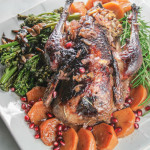
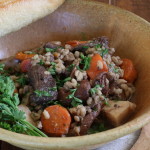
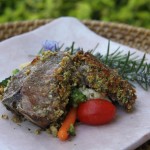



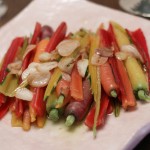
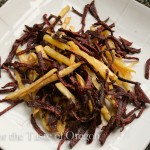


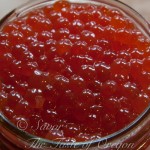
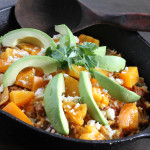
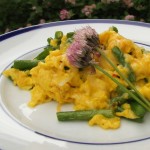
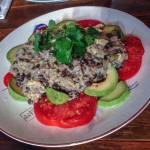
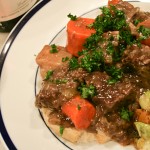
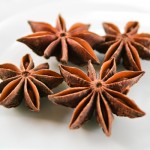



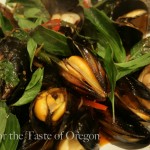


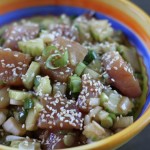
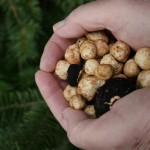




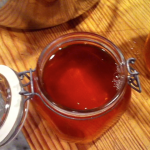











Inspired to grow my own kaffir lime tree….just for the pleasure of plucking a two headed leaf! And great that you can get to learn from your mum - both about food and culture!!!!! Superb
Butterfly - I was just on your site yesterday reading with amazement about your vanilla powder which I can’t wait to try. Vic will be pleased with your comment. I know you’re in The Netherlands now and I’ll bet you can mail order one from hotter climes. Good luck.